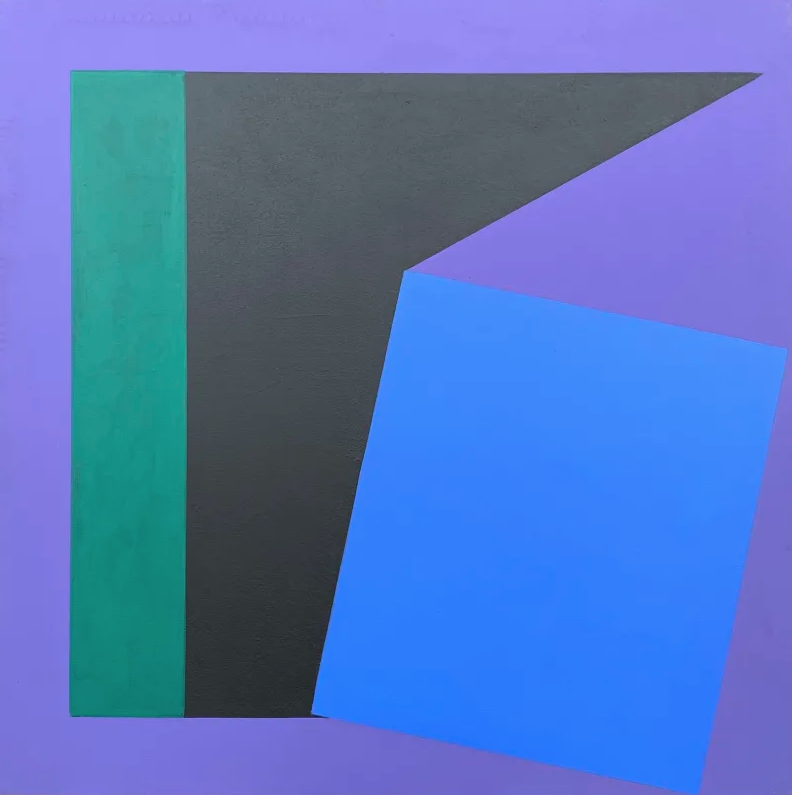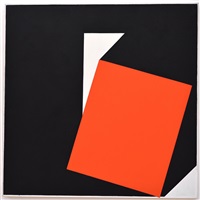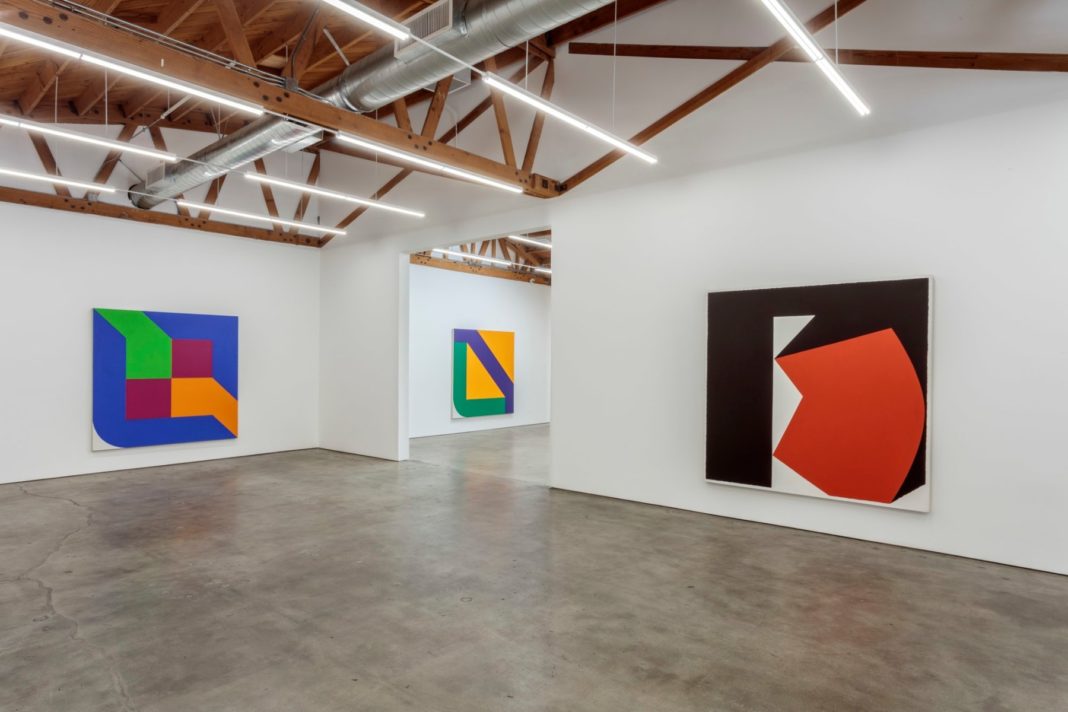Georg Karl Pfahler, German, 1926–2002
Pfahler dedicated his entire career to the investigation of the relationship between colour, shape and space, an objective he steadfastly pursued.
‘Colour has a value of its own, colour is weight, colour is quality, colour possesses an inherent limitation, of itself, through itself, through other colours, colour creates space, colour is form and space’ – Georg Karl Pfahler, 1968.
Rising to prominence in the early 1960s as one of the first hard edge painters in Europe, known for his vibrant and colourful works, Georg Karl Pfahler was an internationally recognised artist who represented Germany at the Venice Biennale in 1970 alongside Günther Uecker, Heinz Mack, and Thomas Lenk; and at the São Paulo Biennale in 1981. Pfahler dedicated his entire career to the investigation of the relationship between colour, shape and space, an objective he steadfastly pursued until his death in 2002. In doing so he was—and remains to this day—at the forefront of the colour field painting movement.
Pfahler was born in 1926 and studied at the Kunstakademie Stuttgart under Willi Baumeister, graduating in 1954. Influenced by the tradition of European Art Informel, he quickly adopted an innovative abstract geometric painting style, with block-like forms on crisp backgrounds appearing on his canvasses as early as 1962. It was then that Pfahler continued to reduce his style even further to exclusively focus on the dynamic between shapes, and to examine the deeper relationships between space and colour. In doing so Pfahler became a thought leader and one of the first European artists to simultaneously work in action, colour field, and hard edge painting—styles that his American contemporaries like Frank Stella, Ellsworth Kelly, Kenneth Noland and Leon Polk Smith, among others, explored as well.
In the late 1970s Pfahler’s work began to take increasingly gestural forms, introducing sweeping blocks of coloured shapes set against minimalistic black or white backgrounds, a stylistic preoccupation that continued to influence his work throughout the 1980s and into the early 1990s. By the late 1990s Pfahler’s compositions had progressed into a new and final direction, where a greater number of forms, layered on top of each other almost like a collage of coloured shapes are distributed across the surface of the canvas, adding a new and never before seen spatial dimension to his paintings.
Georg Karl Pfahler was a leading German painter known for his Hard-Edge abstractions. The artist dedicated his entire career to the investigation of the relationship between color, shape, and space, and was considered at the forefront of the Color Field movement. “In Pfahler’s painting the color has both a displacing and a constitutive function, which bewilders and stimulates the observer to critical reflection,” Peter Beye once wrote of his work. Born in 1926, Pfahler studied at the Kunstakademie Stuttgart under Willi Baumeister, graduating in 1954. Initially working as a sculptor, it was Baumeister who encouraged Pfahler to focus on painting. Influenced by the tradition of European Art Informel, he quickly began to adopt an innovative abstract geometric painting style by the early 1960s. Pfahler continued to reduce his style even further to exclusively focus on the dynamic between shapes, and to examine the deeper relationships between space and color. By the mid 1960s, Pfahler had exhibited alongside artists such as Frank Stella, Ellsworth Kelly, and Kenneth Noland in shows such as “Signale” at the Kunsthalle Basel, Switzerland. In 1966, Pfahler had his first show in the United States at Fischbach Gallery, curated by Barnett Newman. Pfahler went on to represent Germany alongside Gunther Uecker, Heinz Mack, and Kaspar Thomas Lenk at the Venice Biennale in 1970. In the decades that followed, Pfahler continued to experiment with the constraints and boundaries of painting. He died on January 6, 2002 in Emetzheim, Germany. Today, the artist’s works are held in the collections of The Museum of Modern Art in New York, the Städel Museum in Frankfurt, and the Neue Nationalgalerie in Berlin, among others.
BIOGRAPHY
Rising to prominence in the early 1960s as one of the first hard edge painters in Europe, known for his vibrant and colorful works, Georg Karl Pfahler was an internationally recognized artist who represented Germany at the Venice Biennale in 1970 alongside Günther Uecker, Heinz Mack, and Thomas Lenk; and at the São Paulo Biennale in 1981.
Pfahler was born in 1926 and studied at the Kunstakademie Stuttgart under Willi Baumeister, graduating in 1954. Initially working as a sculptor, it was Baumeister who encouraged Pfahler to focus on painting. Influenced by the tradition of European Art Informel, he quickly simplified his paintings to adopt an innovative abstract geometric painting style, with block-like forms on crisp backgrounds appearing on his canvasses as early as 1962.
It was then that Pfahler continued to reduce his style even further to exclusively focus on the dynamic between shapes, and to examine the deeper relationships between space and color. In doing so Pfahler became a thought leader and one of the first European artists to simultaneously work in action, color field, and hard edge painting—styles that his American contemporaries like Frank Stella, Ellsworth Kelly, Kenneth Noland, and Leon Polk Smith, among others, explored as well.
By the mid 1960s Pfahler had arrived on the international stage. Exhibitions such as “Signale” in Basel, Switzerland in 1965 contrasted color field artists from Europe and the United States. Pfahler showed his work alongside Al Held, Elsworth Kelly, Ken Noland, and Jules Olitski, and the critically acclaimed show cemented his status as a leading European artist of his generation. In 1966 Pfahler had his first show in the United States, where Barnett Newman curated his exhibition at Fischbach Gallery in New York. Then, at the Venice Biennale in 1970, Pfahler created one of the highlights of his career to much acclaim; a walkable structure that allowed visitors to physically experience the shape, color and spacial context that is central to his work.
In the late 1970s Pfahler’s work began to take increasingly gestural forms, introducing sweeping blocks of colored shapes set against minimalistic black or white backgrounds, a stylistic preoccupation that continued to influence his work throughout the 1980s and into the early 1990s. By the late 1990s Pfahler’s compositions had progressed into a new and final direction, where a greater number of forms, layered on top of each other almost like a collage of colored shapes are distributed across the surface of the canvas, adding a new and never before seen spacial dimension to his paintings.
Pfahler dedicated his entire career to the investigation of the relationship between color, shape and space, an objective he steadfastly pursued until his death in 2002. In doing so he was—and remains to this day—at the forefront of the color field painting movement, creating an impressive depth of work that is represeneted in several important private and public collections around the world.




Source:
https://www.georgkarlpfahler.com/
https://www.simonleegallery.com/artists/274-georg-karl-pfahler/
https://www.artnet.com/artists/georg-karl-pfahler/
Cover: https://www.miergallery.com/ Installation View of Georg Karl Pfahler, Hard Edge | 1963 -1984, February 18 – March 19, 2022













